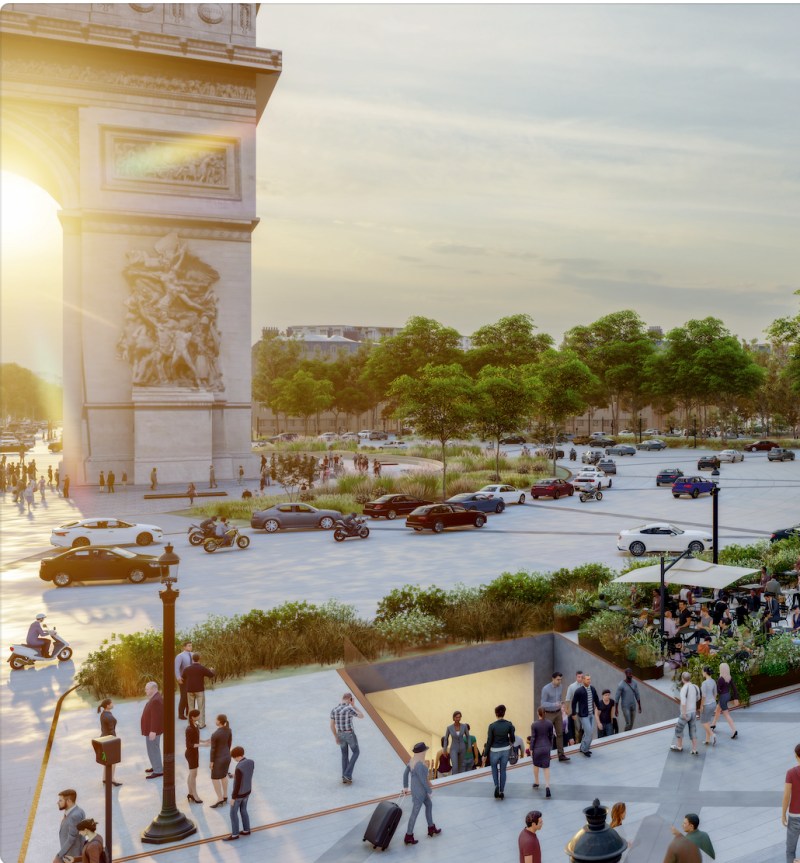As Parisians celebrate a new plan to pedestrianize the Champs-Élysées and cut car traffic in half, Americans street safety advocates are demanding redesigns for their own cities' even more dangerous downtown arterials.
Following a three-year campaign by local advocates, Paris Mayor and sustainable transportation visionary Anne Hidalgo announced on Sunday that the city would undertake a human-centered redesign of the famous eight-lane avenue, which connects the Arc de Triomphe with the Place de la Concorde (the largest plaza in Paris) and has been a mainstay of tourist itineraries for generations.
The plans for the new Champs are already being hailed by urban designers as a perfect marriage of the roadway's historic past a royal garden promenade and its future as gathering space for Parisiens and visitors alike.
The new design was the result of a public engagement effort involving more than 10,000 residents, and will comprehensively reimagine the 1.2-mile road, including transforming four of eight driving lanes into space for pedestrians, cafes, playgrounds, gardens, and generous bike lanes. It will also replace most aging cobblestones with patterned pavers that will smooth the ride for cyclists, and add "tunnels of trees" to provide shade for pedestrians and improve the surrounding air quality.
The Champs-Élysées Committee praised the overhaul "one of the flagship urban projects of this decade." It is scheduled to begin construction after the 2024 Paris Olympics.
The existing 70 foot-wide sidewalks and a double row of traffic-buffering street trees already made a stroll along the Champs-Élysées pretty comfortable by American standards — and the monthly Open Streets events didn't hurt either — but forward-thinking Parisians have long questioned the impact of car culture on the famous thoroughfare. In an interview with the Guardian, one of the architects behind the redesign, Philippe Chiambaretta, criticized the avenue as the embodiment of the worst aspects of the City of Light, which he summed up with distinctly French directness as “pollution, the place of the car, tourism and consumerism.”
The Champs-Élysées is travelled by an average of 3,000 drivers per hour and 100,000 pedestrians per day, and has one of the highest levels of automobile emissions in Paris.
The proposed transformation of an already great street into an even greater one was met with a mixture of jealousy and curiosity by U.S. advocates, who wondered whether America's not-so-people-friendly arterials would ever get their own makeovers.
Many American arterials strive for the grandeur of Champs-Élysées — think New York City's Broadway between Columbus Circle and Union Square, or arguably, Philadelphia's Benjamin Franklin Parkway — but most are more likely to be flanked by strip malls and dicey asphalt shoulders than chic fashion boutiques and 70-foot sidewalks. That's because much of the Unite States' primary arterial network was bbuilt in tandem with the suburbs and designed specifically to center the needs of drivers from day one, rather than retrofitted to prioritize high-speed travel when cars took over older cities and towns.
In 2013, Minnesota-based advocacy group Strong Towns coined the term "stroad" — a portmanteau of the words "street" and "road" — to describe the kind of multi-lane, high-speed thoroughfares adorned with nominal, narrow sidewalks and dangerously infrequent crosswalks that are common to U.S. cities and suburbs alike. Unlike Paris's celebrated promenade, such stroads are often built and maintained by state transportation agencies rather than local officials, which can make successfully requesting even the most basic traffic-calming measures a profound challenge for advocates.
"Each 'larger' scale of government seems to involve a re-setting of the scope along which priorities are balanced," wrote urban geographer Bill Lindeke in an essay on the difficulties of making U.S. arterials safer for road users. "Because the basic road diet trade-off is one that improves local safety (for people living or walking along these streets) but comes at the expense of more regionally-focused travel speeds (for drivers passing through a neighborhood from freeways or surrounding suburbs), it makes it particularly hard for county- or state-level decision makers to reconcile. If history is any guide, county- and state-level governments always prioritize through travel over local safety."
We have a Boulevard meant specifically to copy the Champs-Elysees. We should copy this too. https://t.co/5QfTOOC8ZN
— Daniel Pearson (@DPearsonPHL) January 10, 2021
But some U.S. advocates believe that America's arterials could get their own version of the Champs-Élysées treatment — even if right now, they look more like super-sized highway rest stops than iconic urbanist landmarks.
"We built the suburbs and the inner suburbs around a network of arterials to enhance the car," said Peter Calthorpe in a keynote address at the 2020 Rail~Volution conference. "We lined it with commercial that is dying now because of Amazon and online retail. We have these ribbons of decay everywhere, [but they] can become the places that we infill redevelop and create opportunities for transit. I call it Grand Boulevards. ... You can have good sidewalk environments, bikeways, you can have dedicated lanes for transit."
But even if the path to real arterial reform isn't always easy, U.S. advocates were hopeful that their state and local leaders would be inspired by the Champs-Élysées makeover to think big about how they might redesign even their most deeply car-dominated streets. Because no matter how "historic" a road might be, making it safer for people who walk and roll is always a step in the right direction.
If the Champs-Élysées isn't historically significant enough to preserve in a way that prevents walkability improvements, then neither is Central Avenue in NE Minneapolis.
— Zachary Wefel (@zacharywefel) January 11, 2021







